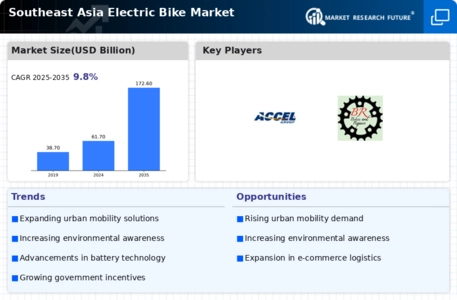Market Analysis
In-depth Analysis of Southeast Asia Electric Bike Market Industry Landscape
The market dynamics of the Southeast Asia electric bike market are influenced by a myriad of factors that shape its growth and development. Firstly, the region's increasing urbanization and traffic congestion have driven the demand for alternative modes of transportation, making electric bikes an attractive option for commuters seeking convenience and eco-friendliness. As governments in countries like Indonesia, Thailand, and Vietnam promote sustainable mobility solutions, incentives and subsidies for electric bikes have spurred market expansion.
Moreover, the affordability of electric bikes compared to traditional automobiles has contributed to their popularity among a diverse demographic, from students to working professionals and even delivery riders. This affordability factor is particularly significant in Southeast Asia, where a sizable portion of the population belongs to the middle or lower-income brackets. Additionally, the compact nature of electric bikes makes them well-suited for navigating the region's bustling streets and narrow alleyways, further driving consumer preference.
In terms of market competition, both domestic manufacturers and international brands vie for a share of the Southeast Asia electric bike market. Local players often focus on catering to specific regional preferences and price points, leveraging their understanding of local consumer needs to gain a competitive edge. On the other hand, international brands bring advanced technology and established reputations to the market, appealing to consumers seeking quality and reliability.
Regulatory frameworks also play a crucial role in shaping market dynamics. While some countries in Southeast Asia have embraced electric bikes as a sustainable transportation solution, others impose restrictions or require registration and licensing for their use. These varying regulations can impact market penetration and consumer adoption rates, influencing manufacturers' strategies and product offerings.
Furthermore, the rise of e-commerce platforms has facilitated the distribution and sale of electric bikes across Southeast Asia, providing consumers with greater accessibility and convenience. Online marketplaces offer a wide range of electric bike models, allowing shoppers to compare prices, features, and reviews before making a purchase decision. This digitalization of the retail landscape has expanded market reach and accelerated the growth of the electric bike sector in the region.
Environmental awareness and concerns about air pollution have also contributed to the increasing popularity of electric bikes in Southeast Asia. As cities grapple with issues of smog and carbon emissions, consumers are turning to cleaner transportation alternatives like electric bikes to reduce their environmental footprint. This growing consciousness aligns with global efforts to combat climate change and promotes the adoption of sustainable mobility solutions.
In conclusion, the market dynamics of the Southeast Asia electric bike market are shaped by a confluence of factors, including urbanization, affordability, competition, regulation, digitalization, and environmental consciousness. As the region continues to undergo rapid economic development and demographic shifts, the demand for electric bikes is expected to rise further. Manufacturers, policymakers, and stakeholders must adapt to these evolving dynamics to capitalize on market opportunities and address emerging challenges in the pursuit of sustainable transportation solutions.


















Leave a Comment